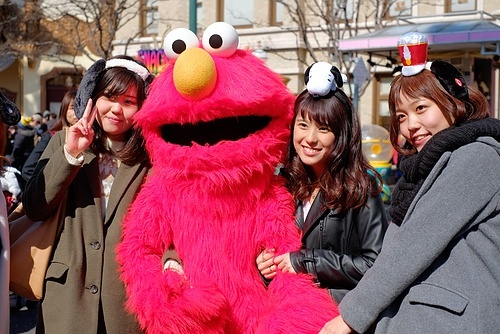Not long ago the new television ad featuring Sesame Street’s Cookie Monster pitching the iPhone 6 would have been considered a deplorable exploitation of children’s culture for profit. But this final collapse of a putatively public educational project into the realm of corporate marketing caused little stir, quite possibly because Big Capitalism was written into Sesame Street’s DNA from Day One.
Sesame Street was born as a ruling class experiment in social control, managed and funded by the Carnegie Endowment in concert with the Ford Foundation and federal agencies. Carnegie’s Children’s Television Workshop (CTW) created the show as a conscious response to late 60s urban insurrections and African-American revolutionary sentiment. CTW, “with its aim to serve the educational needs of the disadvantaged, was born at a moment in the nation’s life when when … racial riots in Newark and Detroit were still fresh in our collective memory.” (James Day, The Vanishing Vision: The Inside Story of Public Television, Berkeley, UC Press, 1995, p. 168.)
Carnegie’s project meshed neatly with the goals of the federal Corporation for Public Broadcasting, then chaired by Frank Pace Jr., a former Secretary of the Army with extensive intelligence connections. Pace, who had created the US Army’s Office of Psychological Warfare, was frankly interested in public television’s “potential for riot control.” (Ralph Engelman, Public Radio and Television in America: A Political History, Thousand Oaks, Cal., Sage, 1996.)
Hence early seasons of Sesame Street were set in a grungy ghetto alley where the peace was kept via the ministrations of a hip young black man sporting an Afro — a model of the federally-funded “community organizers” dispatched to the inner city as a safe alternative to the Panthers. (I also recall a kindly, implicitly Jewish, shopkeeper character, presumably intended to address inner-city resentment toward absentee business owners.) While a multiracial cast endlessly enacted what was then called “brotherhood,” the show’s target audience was offered the basic skills necessary to work behind the counter at McDonald’s.
Seen in this light, Sesame Street was all about recommending a worldview that encouraged coping with racism and bare subsistence rather than daring to imagine social change. Protest was plainly off the menu: the worst thing you could be was a “grouch.” Sunny day; everything’s AOK.
Exemplary fables of racial harmony were of course nothing new in postwar American culture. In fact Sesame Street’s true innovations were not in the area of content but of form. Reflecting Carnegie’s longtime interest in harnessing TV marketing schemes for pedagogical purposes, CTW punctuated its narratives with brief “educational” segments explicitly modeled on television commercials. Numbers and the alphabet were not taught, but rather imprinted, on youthful minds through strategies of repetition and arresting imagery. As both Madison Avenue executives and Washington propagandists well knew, these techniques could lull viewers into a passive, hypnotic state that rendered them especially vulnerable to advertising messages. (Douglas Gomery, “The Rise of American Advertising, Media in America: The Wilson Quarterly Reader, Washington DC, Woodrow Wilson Center Press, 1989, p. 57.)
Corporate America immediately took notice. Most famously, the transnational giant General Foods Corporation produced “Multiplication Rock,” a look-alike series of Saturday morning commercials disguised as educational programming, following up with further TV travesties of civics and American history that hammered home potted lessons in ruling class ideology. Other marketers followed suit, seeing a way to outflank federal regulations governing the content of advertising directed toward children.
Children’s television, and kiddie culture in general, rapidly became an unsavoury mishmosh of corporate messaging and sham “education.” Probably the original Sesame Street generation was the first to grow up without perceiving a clear distinction between teaching and marketing. Their children, now ceaselessly assaulted by corporate sales pitches in the classroom, on television, and via the Internet, may well see no difference at all.
Thus Sesame Street has been instrumental to neoliberalism’s gradual erasure of traditional distinctions between disinterested pedagogy and the pursuit of profit. While corporations seized the opportunity to infiltrate the public sector with commercial messages, the ruling class was well served by a new educational approach that tended to disable critical thinking and encourage passivity among poor children. The latter phenomenon anticipated the current agenda of school privatizers, who are enthusiastically pursuing ever more powerful means of social control via punitive high-stakes testing, rote learning in the form of “skills matrices,” and routine terror in the classroom.
As the Cookie Monster makes clear, today’s poor children need aspire to nothing better than a brand new iPhone 6 as they’re systematically shunted off to privatized chain schools, menial jobs, prisons, and the imperial military. The truly ambitious — emulating Black Lives Matter “spokesman” and charter school advocate Deray McKesson –might even hope for a Patagonia fleece vest.
